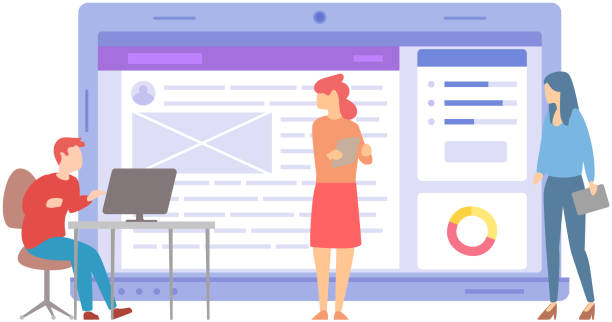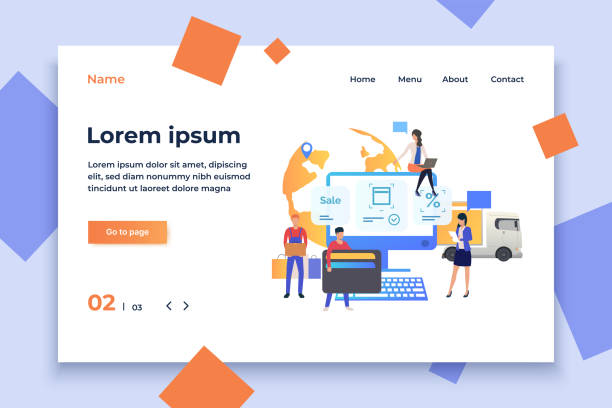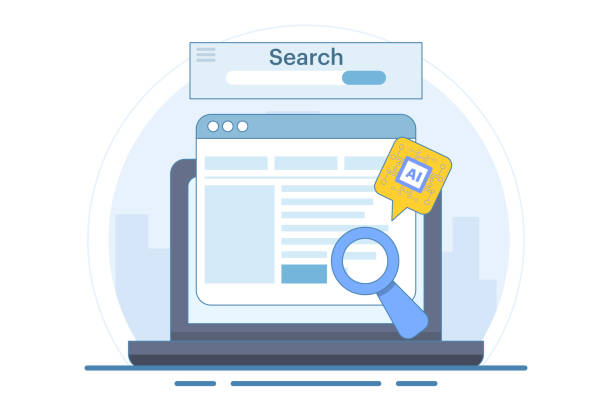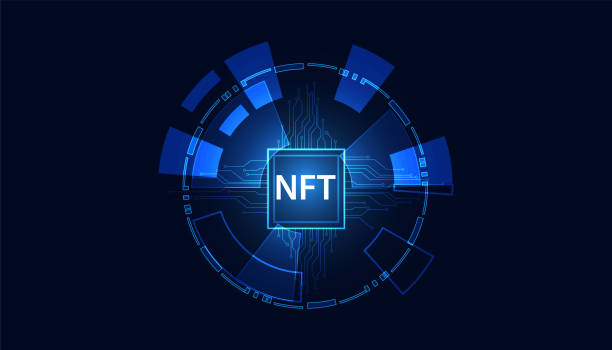An Introduction to Secure Website Design and Its Critical Importance

In the current era, where the internet has become an inseparable part of our daily lives, website design is not only about visual appeal and optimal user experience but also heavily relies on cybersecurity and data protection.
The concept of #SecureWebsiteDesign is no longer a luxury option but an indispensable necessity.
Every website, from a simple personal blog to large e-commerce platforms and online banking, must be protected against various cyber threats.
This not only helps maintain reputation and user trust but also prevents financial and legal damages resulting from data breaches.
This section provides an explanatory and educational approach to the importance of secure website design, helping users gain a deeper understanding of the challenges and solutions in this field.
Secure website design encompasses a set of processes, techniques, and tools employed to reduce vulnerabilities and enhance resistance against cyber attacks.
This field is not limited to secure programming but also includes proper server configuration, the use of strong encryption protocols, effective access management, and user education.
Vulnerable websites can be targeted by various attacks such as SQL Injection, XSS (Cross-Site Scripting), DDoS attacks, and malware intrusions.
Each of these attacks can have catastrophic consequences, from the theft of sensitive user information to the complete unavailability of the website.
Therefore, investing in secure website design is not merely an expense but a smart investment to ensure the long-term stability and success of an online business.
A deep understanding of this topic and implementing security principles from the initial development stages are key to achieving a reliable and resilient online platform.
This proactive approach can save organizations from incurring significant costs associated with post-attack recovery and legal penalties.
Overall, every developer and business owner should prioritize security to fully leverage the potential of the digital space.
Do you know that your website is the first impression customers have of your company? Multiply your business’s credibility with a powerful corporate website from Rasawwb!
✅ Custom and eye-catching design tailored to your brand
✅ Improved user experience and increased customer acquisition
⚡ Get a free consultation!
Common Cyber Threats and How to Identify Vulnerabilities

In the fast-paced world of the web, understanding #CyberThreats and #Vulnerabilities is the first step towards secure website design.
Cyber attackers are constantly devising new methods to infiltrate systems and exploit information.
This section provides a comprehensive analysis of the most common threats and attacks faced by websites and offers guidance on how to identify these weaknesses.
These threats include code injection attacks (SQL Injection, Command Injection), Cross-Site Scripting (XSS), Cross-Site Request Forgery (CSRF), Distributed Denial of Service (DDoS) attacks, and exploitation of security misconfigurations.
Understanding the mechanism of each of these attacks is vital for website developers and administrators to establish effective defenses against them.
This analytical understanding helps us adopt a proactive approach to maintaining website security.
Identifying website weaknesses requires a combination of automated tools and manual reviews.
Web Vulnerability Scanners like Acunetix or Nessus can automatically find many known vulnerabilities.
However, no tool replaces manual penetration testing and code review by security specialists.
These processes help identify weaknesses that automated tools might miss.
Furthermore, paying attention to new security reports and software updates for the platforms used (such as CMSs, frameworks, and libraries) is of paramount importance, as many attacks exploit publicly known vulnerabilities (CVEs).
Secure website design must go beyond fixing known bugs; it must embrace a comprehensive approach including continuous training for the development team, implementing secure coding methodologies, and regularly conducting security tests.
Additionally, having an Incident Response Plan in place for when an intrusion occurs is essential.
This analytical section helps you gain a comprehensive view of threats and their detection methods so you can take effective steps to strengthen your website’s security.
Basic Principles in Secure Website Design and Defense Layers

To ensure #WebsiteSecurity, the principles of #SecureWebsiteDesign must be considered from the very initial stages of the development cycle.
This approach signifies “Security by Design” and emphasizes the importance of security thinking at every stage, from architectural design to implementation and deployment.
This section expertly and educationally outlines the fundamental principles and defense layers that a website must implement to counter cyber attacks.
These principles include the Principle of Least Privilege, Separation of Duties, Input Validation, Encryption usage, and proper Error Handling.
Each of these principles, individually and collectively, provides a robust structure for protecting website information and services.
Defense layers in secure website design resemble a strong fortress with multiple defensive walls; even if one layer is breached, subsequent layers prevent the attacker from accessing sensitive information.
These layers include:
- Infrastructure Security: Secure configuration of servers, firewalls, and networks.
- Programming Security: Secure coding, use of secure and up-to-date frameworks.
- Data Security: Encryption of data in transit and at rest, regular backups.
- User Security: Strong authentication systems, password management, and access control.
- Monitoring and Response: Continuous monitoring of logs, intrusion detection systems (IDS), and incident response plans.
Using a Web Application Firewall (WAF) can also serve as an additional defense layer against common attacks.
The table below illustrates some fundamental principles of secure website design with brief explanations:
| Security Principle | Explanation |
|---|---|
| Input Validation | Thoroughly checking all input data from the user to prevent injection attacks. |
| Principle of Least Privilege | Granting only the minimum access required for users and systems to perform their tasks. |
| Encryption | Protecting data in transit and at rest using strong encryption algorithms. |
| Error Handling | Hiding sensitive information in error messages to prevent information disclosure. |
By implementing these principles and defense layers, we can take a significant step towards ensuring secure website design and creating a website resilient against cyber threats.
The Role of Security Protocols and SSL Certificates in Maintaining Security

One of the main pillars in #WebSecurity and #SecureWebsiteDesign is the use of standard security protocols and SSL/TLS certificates.
This section explanatorily and expertly examines the vital role of these technologies in establishing a secure and reliable connection between the user’s browser and the website server.
When you view a website with the “https://” address, it means that your connection to that website is established via the HTTPS protocol.
HTTPS, which is the secure version of HTTP, uses TLS (Transport Layer Security) or SSL (Secure Sockets Layer) to encrypt data.
This encryption prevents eavesdropping, data tampering, and identity spoofing.
An SSL/TLS certificate is a small digital file installed on a website’s server that acts as a digital identity.
This certificate contains the website’s public key and identity information, verified by a trusted Certificate Authority (CA).
When a user connects to the website, their browser checks the SSL certificate to ensure the website’s authenticity.
If the certificate is valid, an encrypted connection is established, protecting all data exchanged between the user and the server.
This includes sensitive information such as usernames, passwords, credit card details, and personal data.
Using SSL/TLS not only enhances security but is also important for SEO, as search engines like Google rank HTTPS-enabled websites higher.
For any website that collects user information or conducts financial transactions, having SSL/TLS is crucial.
Even for blogs and informational sites, using HTTPS demonstrates professionalism and a commitment to user privacy.
Secure website design would be incomplete without proper HTTPS implementation.
Therefore, ensuring the SSL certificate is up-to-date and using strong TLS versions (such as TLS 1.2 or 1.3) are fundamental actions for every website administrator.
This is an essential step for any secure website design and for building trust with users.
Does your company website create a professional and lasting first impression on potential customers? Rasawwb, with its professional corporate website design, not only represents your brand’s credibility but also paves the way for your business growth.
✅ Building a powerful and trustworthy brand image
✅ Attracting target customers and increasing sales
⚡ Get a free consultation
Strong Password Management and Authentication

One of the weakest links in the cybersecurity chain is often #WeakPasswords and inadequate #AuthenticationMechanisms.
This section guides and educates on the importance of implementing strong password policies and multi-factor authentication (MFA) systems within the framework of secure website design.
Users often tend to use simple and easily guessable passwords, which exposes websites to attacks such as dictionary attacks, Brute Force, and Credential Stuffing.
A strong authentication system can largely prevent these attacks and significantly enhance the security of user accounts.
To strengthen authentication security, websites should encourage users to use complex passwords (including uppercase and lowercase letters, numbers, and symbols) and regularly prompt them to change passwords.
Additionally, implementing password storage systems as hashing with “Salt” (a random string added to the password before hashing) is essential so that even if the database is breached, passwords are not available in plaintext.
More importantly, implementing Two-Factor Authentication (2FA) or Multi-Factor Authentication (MFA) is crucial.
2FA requires the user to provide another factor (such as a code sent to their mobile phone or a fingerprint) in addition to their password to verify their identity.
This significantly enhances security, even if the user’s password has been stolen.
Many successful attacks are the result of neglecting these fundamental points in secure website design.
Educating users about the importance of using strong passwords and enabling MFA is also an integral part of this process.
The website should provide clear guidelines on how to create strong passwords and enable security options.
Implementing these measures not only ensures user security but also significantly increases the website’s credibility and trustworthiness.
These are foundational steps for any secure and sustainable website design.
Continuous Updates and Website Security Monitoring

In the digital world, where #CyberThreats are rapidly evolving, merely #SecureWebsiteDesign at the outset is not enough.
This section, presented as news-oriented and guidance, emphasizes the importance of continuous updates and ongoing website security monitoring.
Many successful attacks occur due to the untimely updating of software, plugins, frameworks, and server operating systems.
Every security update usually includes fixes for discovered vulnerabilities that hackers might exploit.
Neglecting these updates means leaving entry doors open for attackers.
Website administrators must have a regular schedule for reviewing and applying updates.
This includes updating the Content Management System (CMS) such as WordPress, Joomla, or Drupal, all plugins and themes used, programming libraries, and even the server’s operating system and database software.
In addition to updates, continuous website security monitoring is also essential.
This monitoring involves checking server logs for suspicious activities, using Intrusion Detection Systems (IDS) and Intrusion Prevention Systems (IPS), as well as regular scans for malware and vulnerabilities.
Security monitoring tools can automatically detect unusual activities and issue alerts.
For instance, if core website files are modified without authorization or unusual traffic is directed to the server, monitoring systems should immediately issue alerts.
Having a team or specialized tools for quick response to these alerts is crucial.
Ultimately, secure website design is not a static process but a continuous effort to adapt to the changing threat landscape.
Staying aware of the latest security news and advancements in cyber defense helps administrators always be one step ahead of attackers.
This continuous monitoring and updating process is a key element for maintaining secure website design over time.
Database Security and Protection of Sensitive Information

Databases are the main repositories of sensitive user #SensitiveInformation and the core of every #DynamicWebsite.
Therefore, #DatabaseSecurity is a critical element in secure website design.
This section expertly and explanatorily outlines strategies for protecting information stored in the database against unauthorized access and attacks.
Many successful attacks on websites aim to access the database and steal, destroy, or manipulate information.
SQL Injection attacks are one of the most common methods for infiltrating databases, allowing an attacker to execute arbitrary commands in the database by injecting malicious SQL code into website inputs.
To ensure database security, several key actions must be taken:
- Strong Input Validation: All user inputs must be carefully checked and sanitized to prevent SQL injection attacks.
Using Prepared Statements and Stored Procedures instead of direct string concatenation is a highly effective method. - Data Encryption: Highly sensitive information such as passwords, credit card details, and national IDs must be encrypted before being stored in the database.
Encryption should be applied not only for “Data at Rest” but also for “Data in Transit” via SSL/TLS. - Precise Access Control: Users and applications should be granted only the minimum necessary access to the database.
Database user accounts must have strong passwords, and default accounts should never be used. - Regular Backups: Regular and secure backups of the database provide the ability to recover information in case of an attack or system failure.
- Updates and Monitoring: Database software must always be up-to-date, and its logs should be regularly monitored for suspicious activities.
| Security Action | Effect on Database Security |
|---|---|
| Input Validation | Prevents SQL injection attacks and data manipulation. |
| Data Encryption | Protects sensitive information in case of a database breach. |
| Access Control | Restricts unauthorized access to data and database functions. |
| Backup | Enables data recovery after attacks or failures. |
By meticulously implementing these solutions, we can ensure that secure website design effectively protects its vital information.
Penetration Testing and Vulnerability Assessment

After #WebsiteDesignAndImplementation, the critical stage of #PenetrationTesting and #VulnerabilityAssessment arrives.
This section analytically and expertly discusses the importance of these processes in discovering security weaknesses before attackers can exploit them.
Penetration testing is the simulation of a real cyber attack on your system with prior permission, performed by security specialists (usually ethical hackers).
The goal is to identify vulnerabilities and weaknesses in the system, network, and web applications.
The main difference between vulnerability assessment and penetration testing lies in their depth and approach.
Vulnerability assessment is a broader, more automated scan that identifies a large number of known vulnerabilities and provides a report on them.
This process is designed to identify “what vulnerabilities exist?”
In contrast, penetration testing is deeper and attempts to exploit discovered vulnerabilities to determine “what impact does it have on the system?”
Penetration testing can involve various scenarios, including Black Box tests (without prior knowledge of the system) and White Box tests (with full knowledge of the system).
The results of these tests help developers and website administrators, with a practical understanding of vulnerabilities, to correct them and strengthen their secure website design.
These reports include detailed recommendations for addressing security issues.
Regularly performing these tests, especially after any major website changes or the release of new features, is crucial.
By doing so, one can ensure that your website is protected against the latest threats.
A secure website design requires continuous review and testing to withstand escalating threats.
Many organizations now conduct these tests quarterly or even monthly to ensure the stability and security of their online platforms and always stay one step ahead of attackers.
Are you falling behind in the competition with large online stores?
Rasawwb, with professional e-commerce website design, brings your business online and increases your market share!
✅ Boosting brand credibility and customer trust
✅ Easy shopping experience leading to more sales
⚡ For a free website design consultation, act now!
New Challenges and Solutions in Secure Website Design

The world of #CyberSecurity is rapidly changing, and with the emergence of #NewTechnologies, security challenges are becoming more complex.
This section, presented as thought-provoking content and analytical, examines the emerging challenges in secure website design and advanced solutions to combat them.
Are traditional security approaches sufficient to counter today’s intelligent and automated threats? With the increasing use of Artificial Intelligence (AI) and Machine Learning (ML) in cyber attacks, can we still rely on manual methods?
One of the biggest challenges today is the emergence of AI-powered attacks that can identify defensive patterns and adapt themselves to bypass them.
Additionally, the growth of the Internet of Things (IoT) and Open APIs has created new attack vectors that require novel security approaches.
To address these challenges, secure website design must go beyond traditional defensive measures.
New solutions include:
- Using AI and Machine Learning in Defense: AI/ML-based security systems can detect unusual traffic patterns and predict and neutralize complex attacks before they occur.
- API Security: With the increased use of APIs in microservices architecture, API security must be considered a priority.
This includes strong authentication, rate limiting, and meticulous input/output validation for APIs. - Cloud Security: With the widespread migration to cloud infrastructures, Cloud Native security and proper configuration of cloud environments are crucial to prevent data leaks and unauthorized access.
- Zero Trust Architecture: This security model is based on the principle of “never trust, always verify.” This means that no user or device, whether inside or outside the network, should have access to resources without strict authentication and authorization.
- Continuous Training and Security Awareness: Increasing awareness among the development team and users about the latest threats and best security practices.
These challenges indicate that secure website design is not a static process but a continuous journey of innovation and adaptation.
Websites that are pioneers in this field not only protect themselves but also gain user trust and ultimately achieve greater commercial success.
The future of website security lies in our ability to anticipate and react to threats using the most advanced technologies and novel approaches.
Conclusion and the Future of Secure Website Design

As discussed in this comprehensive article, #SecureWebsiteDesign is not just a technical requirement but an engaging yet critical aspect that demands continuous attention and commitment from developers and website administrators.
In a world where reliance on the digital space is increasing, the importance of protecting data and user privacy has never been higher.
This concluding section provides an explanatory summary of the key points presented in previous sections and discusses the future of this field.
We learned that secure website design goes beyond simply installing an SSL certificate; it’s a multifaceted process that includes implementing secure coding principles, strong password management, continuous monitoring, regular updates, and the use of advanced penetration testing tools.
From common threats like SQL Injection and XSS to emerging challenges such as AI-powered attacks and API security, every aspect of a website must be designed and managed with a security-first approach.
The future of secure website design is moving towards broader use of artificial intelligence for threat detection, automation of security processes, and the implementation of security models like Zero Trust on a larger scale.
Given the increasing complexity of attacks and the capabilities of attackers, websites must constantly learn and adapt.
This means that development and security teams must be continuously trained and equipped with the latest knowledge and tools.
Investing in secure website design is not only technically sound but also a business imperative.
User trust is the backbone of any online business, and a security breach can quickly erode this trust, causing irreparable damage to reputation and profitability.
Therefore, any company seeking sustainable success in the digital world must consider website security a top priority.
Remember, secure website design is a journey, not a destination.
Frequently Asked Questions
| Row | Question | Answer |
|---|---|---|
| 1 | What is secure website design? | Secure website design is a process in which websites are built with security measures in mind from the initial stages of development to protect against cyber attacks, unauthorized access, and data loss. |
| 2 | Why is secure website design important? | Website security is vital for maintaining user trust, protecting sensitive information (personal and financial), preventing damage to brand reputation, and complying with privacy and security regulations (such as GDPR). A security breach can lead to financial and legal damages. |
| 3 | What are the most common cyber attacks a website faces? | Some of the most common attacks include SQL Injection, Cross-Site Scripting (XSS), Distributed Denial of Service (DDoS), Brute Force, and Credential Stuffing attacks. |
| 4 | What is SQL Injection and how can we prevent it? | SQL Injection is a type of attack where the attacker attempts to manipulate the database or extract information by injecting malicious SQL code into website inputs. To prevent it, one should use Prepared Statements/Parameterized Queries, ORM (Object-Relational Mapping), and meticulous input validation. |
| 5 | What is Cross-Site Scripting (XSS)? | XSS is a type of attack where an attacker injects malicious scripts (usually JavaScript) into web pages, which are then executed by other users’ browsers. This can lead to the theft of cookies, session information, or alteration of the website’s appearance. |
| 6 | How can Brute Force attacks on login pages be prevented? | To prevent Brute Force attacks, one should use CAPTCHA, limit the number of failed login attempts (Account Lockout), Two-Factor Authentication (2FA), and encourage the use of complex and long passwords. |
| 7 | What is the role of HTTPS in website security? | HTTPS encrypts the communication between the user’s browser and the website server using SSL/TLS. This prevents eavesdropping, tampering, or spoofing of information during transmission and increases user trust. |
| 8 | What is the importance of Input Validation in security? | Input Validation is the process of checking and sanitizing data entered by the user. This prevents malicious code injection, XSS attacks, SQL Injection, and other vulnerabilities, ensuring that data conforms to the expected format. |
| 9 | Why is regular updating of website systems and software essential? | Regularly updating the operating system, CMS (like WordPress), plugins, themes, and libraries used fixes known security vulnerabilities. Hackers often exploit weaknesses in outdated software to gain unauthorized access. |
| 10 | What role do regular backups play in secure website design? | Regular and tested backups of website data (database and files) are a vital layer of defense against data loss due to cyber attacks, human errors, or hardware failures. This allows for quick website recovery in the event of a disaster. |
And other services of Rasawwb Advertising Agency in the field of advertising:
Smart Content Strategy: Designed for businesses seeking user engagement through attractive UI design.
Smart Conversion Rate Optimization: A professional solution for user engagement with a focus on custom programming.
Smart Digital Advertising: Professional optimization for customer acquisition using precise audience targeting.
Smart Advertising Campaign: A professional solution for digital branding with a focus on intelligent data analysis.
Smart Website Development: Designed for businesses seeking user engagement through custom programming.
And over hundreds of other services in internet advertising, advertising consultation, and organizational solutions.
Internet Advertising | Advertising Strategy | Advertorials
Sources
Important Tips for Secure Website DesignHow to Secure Your Website?Website Security ChecklistComprehensive Guide to Website Security
? Are you ready to transform your business in the digital world? Rasawwb Afarin, a leading digital marketing agency, is by your side with years of experience and expertise to turn your online dreams into reality. We deliver a powerful and effective digital presence for your brand by providing innovative solutions in website design with modern user interfaces, SEO, social media management, and targeted advertising campaigns.
Relying on up-to-date knowledge and a data-driven approach, we help you accurately attract your target audience and maximize your conversion rates. From initial consultation to full project execution, Rasawwb Afarin’s expert team will be with you every step of the way to help you achieve results beyond your expectations.
For a free consultation and to learn more about our services that guarantee the future of your business, contact us today and start your digital success journey.
📍 Tehran, Mirdamad Street, Next to Bank Markazi, Kazeroun Jonoubi Alley, Ramin Alley No. 6


